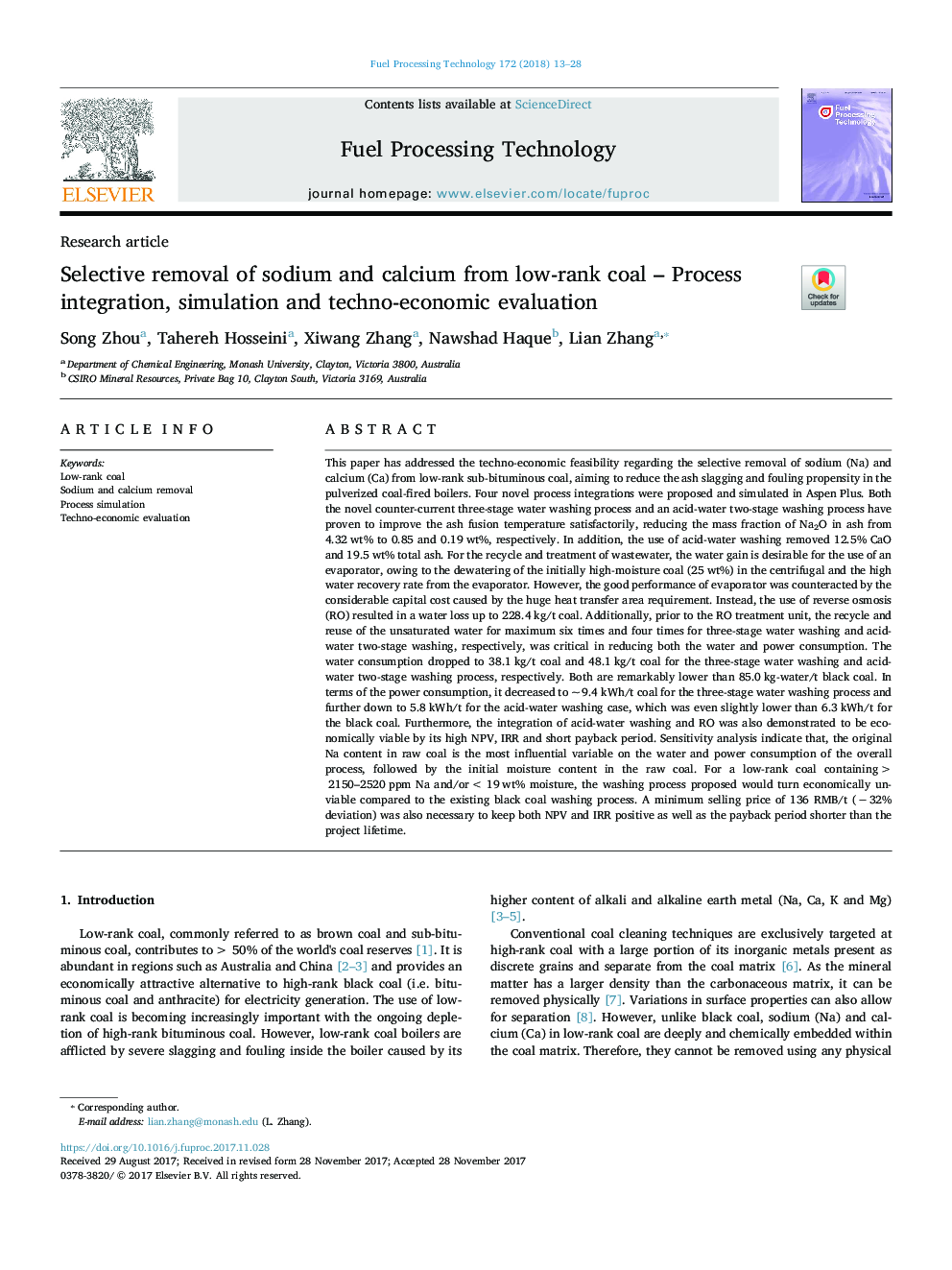| کد مقاله | کد نشریه | سال انتشار | مقاله انگلیسی | نسخه تمام متن |
|---|---|---|---|---|
| 6656460 | 1425374 | 2018 | 16 صفحه PDF | دانلود رایگان |
عنوان انگلیسی مقاله ISI
Selective removal of sodium and calcium from low-rank coal - Process integration, simulation and techno-economic evaluation
ترجمه فارسی عنوان
حذف انتخابی از سدیم و کلسیم از زغال سنگ کم - یکپارچه سازی فرایند، شبیه سازی و ارزیابی فنی و اقتصادی
دانلود مقاله + سفارش ترجمه
دانلود مقاله ISI انگلیسی
رایگان برای ایرانیان
کلمات کلیدی
زغال سنگ کم حذف سدیم و کلسیم، شبیه سازی فرآیند، ارزیابی فنی و اقتصادی،
موضوعات مرتبط
مهندسی و علوم پایه
مهندسی شیمی
مهندسی شیمی (عمومی)
چکیده انگلیسی
This paper has addressed the techno-economic feasibility regarding the selective removal of sodium (Na) and calcium (Ca) from low-rank sub-bituminous coal, aiming to reduce the ash slagging and fouling propensity in the pulverized coal-fired boilers. Four novel process integrations were proposed and simulated in Aspen Plus. Both the novel counter-current three-stage water washing process and an acid-water two-stage washing process have proven to improve the ash fusion temperature satisfactorily, reducing the mass fraction of Na2O in ash from 4.32 wt% to 0.85 and 0.19 wt%, respectively. In addition, the use of acid-water washing removed 12.5% CaO and 19.5 wt% total ash. For the recycle and treatment of wastewater, the water gain is desirable for the use of an evaporator, owing to the dewatering of the initially high-moisture coal (25 wt%) in the centrifugal and the high water recovery rate from the evaporator. However, the good performance of evaporator was counteracted by the considerable capital cost caused by the huge heat transfer area requirement. Instead, the use of reverse osmosis (RO) resulted in a water loss up to 228.4 kg/t coal. Additionally, prior to the RO treatment unit, the recycle and reuse of the unsaturated water for maximum six times and four times for three-stage water washing and acid-water two-stage washing, respectively, was critical in reducing both the water and power consumption. The water consumption dropped to 38.1 kg/t coal and 48.1 kg/t coal for the three-stage water washing and acid-water two-stage washing process, respectively. Both are remarkably lower than 85.0 kg-water/t black coal. In terms of the power consumption, it decreased to ~ 9.4 kWh/t coal for the three-stage water washing process and further down to 5.8 kWh/t for the acid-water washing case, which was even slightly lower than 6.3 kWh/t for the black coal. Furthermore, the integration of acid-water washing and RO was also demonstrated to be economically viable by its high NPV, IRR and short payback period. Sensitivity analysis indicate that, the original Na content in raw coal is the most influential variable on the water and power consumption of the overall process, followed by the initial moisture content in the raw coal. For a low-rank coal containing > 2150-2520 ppm Na and/or < 19 wt% moisture, the washing process proposed would turn economically unviable compared to the existing black coal washing process. A minimum selling price of 136 RMB/t (â 32% deviation) was also necessary to keep both NPV and IRR positive as well as the payback period shorter than the project lifetime.
ناشر
Database: Elsevier - ScienceDirect (ساینس دایرکت)
Journal: Fuel Processing Technology - Volume 172, April 2018, Pages 13-28
Journal: Fuel Processing Technology - Volume 172, April 2018, Pages 13-28
نویسندگان
Song Zhou, Tahereh Hosseini, Xiwang Zhang, Nawshad Haque, Lian Zhang,
